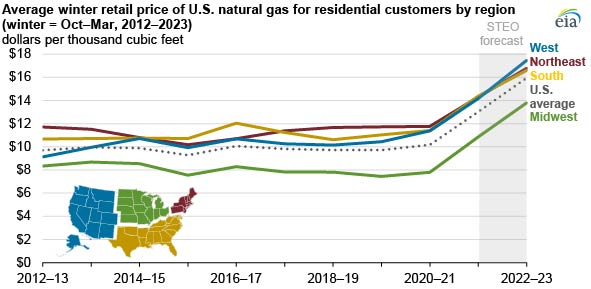
In our latest Winter Fuels Outlook, we forecast that U.S. households that primarily use natural gas for space heating will spend an average of $931 on heating this winter (October–March), which is 28% (or $206) more than last year.
Natural gas is the primary heating fuel for 47% of U.S. homes, according to the U.S. Census Bureau’s 2021 American Community Survey. The retail price of natural gas and the amount of natural gas consumed determine how much households spend on winter natural gas bills.

This winter, higher retail natural gas prices are the main driver for the expected increase in natural gas bills. On average, we expect retail natural gas prices to rise 22%, from $13.02 per thousand cubic feet (Mcf) last winter to $15.95/Mcf this winter. We expect retail natural gas prices in the Midwest to increase the most nationally, by 27% compared with last winter, to $13.80/Mcf.
The increase in retail prices reflects rising natural gas spot prices over the past year. We forecast the natural gas spot price at the U.S. benchmark Henry Hub will increase 54% from last winter to average $7.26 per million British thermal units. Changes in natural gas spot prices are typically reflected in the retail price over a period of months because of the way these costs are handled in regulated rates.
Spot price spikes from previous years can affect current retail prices. For example, regional natural gas spot prices approached record highs following Winter Storm Uri in February 2021, especially in the Midwest. Following that price spike, spot prices quickly returned to pre-winter-storm levels. Many utility companies in states affected by the storm filed motions with their states’ public utility commissions detailing plans to recover the extremely high natural gas costs they had incurred following the winter storm. For example, in Colorado, these plans add a line item charge to utility bills for the next several years to spread the cost out over a long period of time.
This winter, we expect colder temperatures and slightly more household consumption to contribute to higher natural gas bills compared with last winter. For households that use natural gas as their primary space heating fuel, we expect average consumption this winter to increase by 5%, or 58.4 Mcf, from last winter.


Follow us on social media: